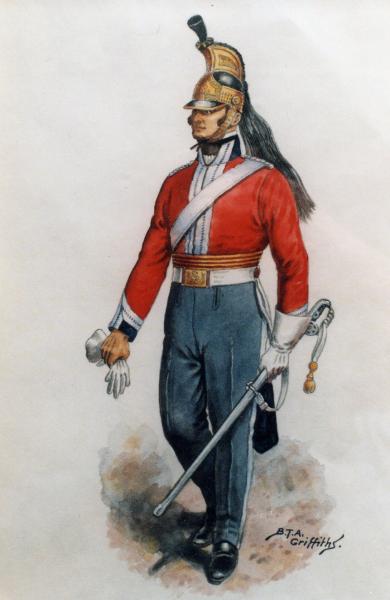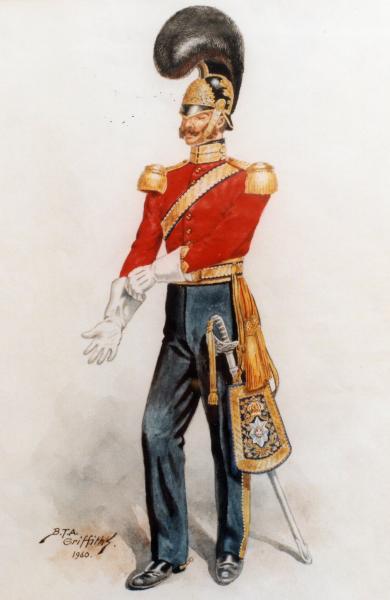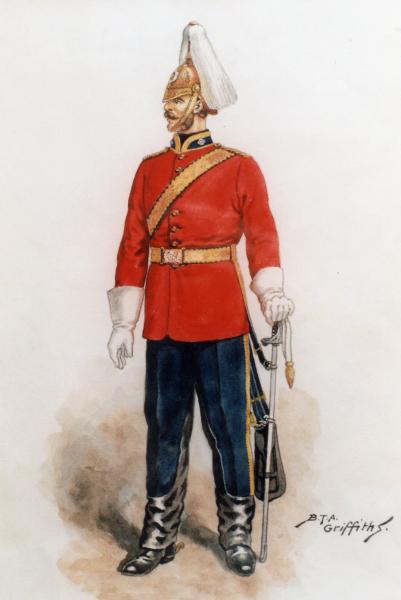

The Royal Dragoon Guards was formed on 1 August 1992, as a result of the amalgamation of the 4th/7th Royal Dragoon Guards and the 5th Royal Inniskilling Dragoon Guards. Both of these were in turn the result of earlier amalgamations in the 1920's. The Royal Dragoon Guards now carries with it the traditions and history of four of the finest Regiments of the British Cavalry, the 4th Royal Irish Dragoon Guards, the 5th Dragoon Guards, the 7th Dragoon Guards and the 6th Inniskilling Dragoons. All four were raised between 1685 and 1689, during the protracted contest between James II and William of Orange for the English throne.
Both the 4th and 5th Dragoon Guards were formed in 1685 from Troops of Horse raised by James II to defend London from the invasion. The Regiments were originally known as Arran's Horse and Shrewsbury's Horse, taking the names from their Commanding Officers, as was the custom in those times. In the event, these Regiments, together with the rest of James's Army, refused to support him and he fled to France, abandoning the throne to William of Orange. The next year, however, still claiming the throne, he landed in Ireland. Only Carrickfergus, Londonderry and Enniskillen held out against him. The town of Enniskillen raised three Regiments from Protestants who had taken refuge there. One of these was Conyngham's Dragoons, which became the 6th Inniskilling Dragoons. On 11th June 1690, King William himself landed at Carrickfergus with a Protestant Army, which included both the 4th and 5th Dragoon Guards, and on the 1st July that year, all three Regiments fought side by side at the Battle of the Boyne. James was defeated and returned to France.
Back in England in 1688, Lord Devonshire raised six Troops of Horse to mark his support for the new Protestant King. Devonshire's Horse, as they were known, became the 7th (Princess Royal's) Dragoon Guards. Within a few years they were to find themselves, together with the 5th Dragoon Guards, embarked for Holland and Marlborough's famous campaigns; both Regiments earning honours side by side at Blenheim, Malplaquet, Ramillies and Oudenarde, as well as the celebrated cavalry action at Elixem in 1705 where the 5th Dragoon Guards captured Standards from the Bavarian Horse Grenadiers.

In 1720, King George I conferred the Colonelcy of the 7th Dragoon Guards on Colonel John Ligonier. His influence was profound, and during his twenty nine year tenure, the Regiment was to reach a peak of discipline and training. It was at this time they acquired the nickname 'The Black Horse', and together with the 6th Inniskilling Dragoons, took part in the 1742 campaign in the War of the Austrian Succession, gaining further honours; Dettingen and Fontenoy. At Dettingen, Cornet Richardson of the 7th received thirty seven wounds whilst defending the Regimental Standard. This Standard, the oldest surviving in the Army, is held by this Museum. Little more than ten years later, the 6th and the 7th again found themselves marching side by side, this time through Paderborn to the Battle of Warburg, where both Regiments took part in the famous Cavalry Charge which won the day over the French for the Allied Forces under the Marquis of Granby.
All the while our two senior Regiments the 4th and 5th , were languishing in Ireland, clocking up a total of some one hundred and eighty years of joint service in that country. However, their moment was shortly to come. Both played a major role in Wellington's Peninsula campaign and gained honours including Salamanca, where the 5th Dragoon Guards captured the Staff of the Drum Major of the French 66th Infantry Regiment. This Staff is still carried today on parades by the Senior Regimental WO2. Colonel Sir William Ponsonby, who commanded the Regiment at Salamanca, was later killed whilst leading the Union Brigade charge at Waterloo. The Inniskillings, who took part in this charge, were so praised by the Duke of Wellington that a statue ofan Inniskilling Dragoon was erected on t he Wellington Memorial in Hyde Park.
he Wellington Memorial in Hyde Park.
In 1854, the 4th, 5th and the 6th, who had last fought together at the Boyne, rode together in the charge of the Heavy Brigade at Balaclava. In this action, eight hundred men, commanded by General James York-Scarlett, himself a past Commanding Officer of the 5th Dragoon Guards, utterly routed nearly three thousand five hundred of the Tsar's finest Cavalry, with minimal loss to themselves, and so demoralised the Russian horseman that they did not dare to follow up the subsequent disaster to the Light Brigade later that same day.
After the Crimean War came several years of service at home and in India for all our parent Regiments. The peace time routine was broken briefly for the 4th and the 7th when in 1882, they took part in the short, but spectacularly successful campaign to defeat the forces of Arabi Pasha in Egypt. The campaign culminated in the battle Tel El Kebir when an Egyptian Force of thirty eight thousand men and sixty guns were defeated with the loss of only fifty seven all ranks killed; the 4th and the 7th Dragoon Guards escaping without a single casualty.
 Such one sided success was not to be repeated, however, during the Boer War of 1899-1902, the 5th Dragoon Guards formed part of the force besieged at Ladysmith, whilst the 6th Inniskillings and the 7th 'Black Horse' earned their spurs in innumerable skirmishes and many long patrols over the Veldt. Two Officers serving at that time were later to achieve world fame, Lieutenant Colonel Robert Baden-Powell, who commanded the 5th Dragoon Guards, was to put his South African experience to good use as the founder of the Boy Scout Movement, while Captain L E G Oates, of the 6th Inniskilling Dragoons, became a legend of self sacrifice when, as a member of Scott's ill-fated Antarctic Expedition of 1912, he chose to sacrifice himself rather than impede the progress of his comrades.
Such one sided success was not to be repeated, however, during the Boer War of 1899-1902, the 5th Dragoon Guards formed part of the force besieged at Ladysmith, whilst the 6th Inniskillings and the 7th 'Black Horse' earned their spurs in innumerable skirmishes and many long patrols over the Veldt. Two Officers serving at that time were later to achieve world fame, Lieutenant Colonel Robert Baden-Powell, who commanded the 5th Dragoon Guards, was to put his South African experience to good use as the founder of the Boy Scout Movement, while Captain L E G Oates, of the 6th Inniskilling Dragoons, became a legend of self sacrifice when, as a member of Scott's ill-fated Antarctic Expedition of 1912, he chose to sacrifice himself rather than impede the progress of his comrades.
Both the 4th and the 5th Dragoon Guards saw action from the outset of the First World War. Indeed history allows C Squadron, the 4th Dragoon Guards the honour of the first action by the British Army in the War, with Corporal Thomas firing the first shot and Captain Hornby the first officer to draw blood with his sword. Only a few days later the Commanding Officer of the 5th Dragoon Guards, Lieutenant Colonel G K Ansell, was killed in action at Nery. By October of that year both the Inniskillings and the 7th had arrived in France from India. All four Regiments spent the greater part of the next four years acting in the dismounted role, but the last weeks of the War found both the 5th Dragoon Guards and the 7th Dragoon Guards in action again on horseback; the 5th capturing or killing over seven hundred German troops when they attacked a troop train at Harbonniers, and the 7th claiming the last cavalry action of the War when they captured the town of Lessines.

In 1922, the large reductions in strength of the Army brought about widespread amalgamation of cavalry regiments. The 4th Royal Irish were combined with the 7th (Princess Royal's) Dragoon Guards to form the 4th/7th Dragoon Guards, while the 5th and 6th amalgamated to form, initially the 5th/6th Dragoons, but in 1927 this was changed to the 5th Inniskilling Dragoon Guards. In the mid-1930s the title 'Royal' was awarded to both Regiments. 1938 brought about mechanisation for both Regiments, both initially equipped with 4.5 ton two-man MK2 Light Tanks.
Only one year after mechanisation came mobilisation and the start of World War 2. The two Regiments were the first armoured units to be deployed to France in support of the British Expeditionary Force, fighting side-by-side in the desperate but gallant withdrawal to Dunkirk. Both Regiments spent the next four years training and re-equipping with heavier tanks in preparation for the Normandy landings. In 1940 a cadre of men from both Regiments was formed which was to be the nucleus of a newly raised Cavalry Regiment, the 22nd Dragoons. The 22nd Dragoons were disbanded after the war. On D-Day, the specially prepared waterproofed tanks of the 4th/7th Royal Dragoon Guards (DD Tanks) were the first tanks ashore. As part of the Eighth Armoured Brigade, the 4th/7th were the first armour to cross the River Seine and led the rescue column to Arnhem. The 5th Royal Inniskilling Dragoon Guards (the Skins) for their part were in almost continuous action from Normandy to the end of the War, taking part in the successful action to capture S-Hertogenbosch and the breakout from the Rhine bridgehead.
After the war, the 4th/7th were dispatched to Palestine to help in the peace keeping operations. The Skins completed tours in Korea and the Suez Canal. Since the mid 1950s, both Regiments have served in the Middle East, Aden, England, Germany, Northern Ireland and Cyprus. The Royal Dragoon Guards, by then equipped with the Challenger MBT, were stationed in Germany upon amalgamation, before returning to Catterick, North Yorkshire, in the early 21st Century. Having served tours in recent conflicts, including the Second Gulf War (Operation Telic) and the War in Afghanistan (Operation Herrick), The Royal Dragoon Guards, now a multi-role armoured cavalry regiment, continue to this day their 300-year tradition of service.
Really enjoyed the history listen! Well done. Gy/Sgt Don Dalton Ret. U S M C Tanker
Korea and Viet Nam Vet.
Gy/Sgt Don Dalton U S M C Ret